What Happens When an Outdoor Afro Visits Soul Food Farm?
Hello there Outdoor Afros! Kelly here from the Acta Non Verba: Youth Urban Farm Project!
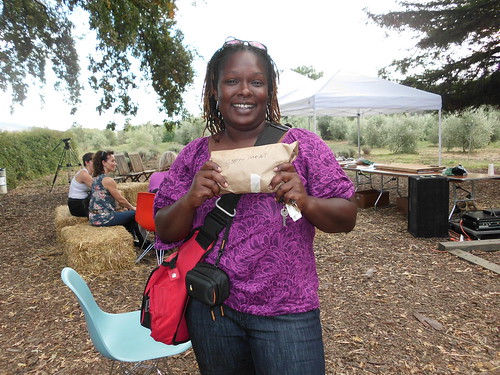
This past Saturday I was a guest of Outdoor Afro and Soul Food Farm at their annual benefit for Slow Food Solano, and the Farmer Veteran Coalition in Vacaville, CA. I have to tell you, I had a GREAT time! It was a day of firsts for me, the first time I’ve ridden my ’86 Honda Shadow for an hour straight, the first time I’ve ridden over a bridge, and the first time I’ve ever watched beef butchered. And I learned all new vocabulary, like:
char•cu•te•rie
Definition of CHARCUTERIE : a delicatessen specializing in dressed meats and meat dishes; also : the products sold in such a shop...
Which I discovered meant people and places that make bacon, sausage and other cured meats. YUM!
Click to check out all my photos!
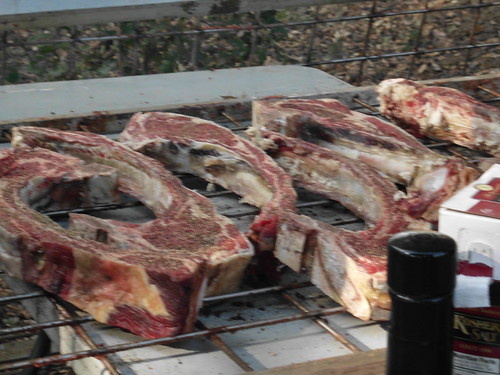
I also learned how professionally trained butchers “break down” beef. It was fascinating watching my favorite cuts of meat being sliced away from a whole cow. You don’t get more real than that! I even walked away with a packet of grass-fed beef stew meat I won in the raffle! Agricola Grassfed Beef donated the cow and from the lunch we had- from pastrami sandwiches to beef tacos (my personal favorite) to the most delicious ribs I’ve ever tasted. How beef is raised and butchered makes a huge difference in taste!
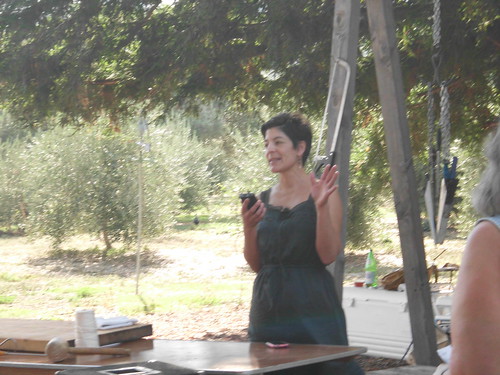
Seriously, beef, beer and butchers with chain link belts on… I was in Kelly-Heaven!
The owner of Soul Food Farm, Alexis, was so welcoming to all of her guests! She spoke to everyone about the importance of supporting both the slow food movement, school gardens, and returning veterans. She and her volunteers have our thanks for everything they do!
Thank you Rue of Outdoor Afro and Soul Food Farm for inviting Acta Non Verba: Youth Urban Farm Project to this “first in a lifetime” opportunity!
Best,
Kelly D. Carlisle
Founder/ Executive Director
Acta Non Verba: Youth Urban Farm Project
Ph: 510.972.3276
A Couple Discovers Mount Lemmon, Arizona
Eliss Jackson shared on facebook a photo where she was recently SOS (Spotted on Sunday). I asked her to share more, so here is her wonderful report (Thanks Eliss!):
This month, my fiancé Joseph and I rented a log cabin on Mt. Lemmon. We went because we needed a break from this chaos called "life," and we wanted to relax. With us both working demanding jobs, coupled with me going back to school...and planning a wedding, stress has been knocking on our back door.
We're both lovers of nature, and live in Arizona that has many outdoor activities to offer, and we enjoy taking advantage of them. I fell in love with Mt. Lemmon the first time Joseph took me in August of this year. Mt. Lemmon's beauty is one that can't be described; you just have to go and visit to see why we are now so addicted to it!
What I can say is that our infatuation with this place is partly based on the fact that we seem to experience a spiritual connection to the land -- there is this one place in particular called "Inspirational Rock," which sits 9,000 ft in the air (so it's a bit of a drive and hike up), and when you reach the apex, you feel as though you have a connection with God.
While on a "spiritual high," you can also receive a physical high because you will definitely workout your body via hiking the plethora of hills! It's also a great area for running and cycling, as many athletes reside on the mountain for training purposes.

Where were YOU Spotted on Sunday?
Follow Our Upcoming RV Trip to the California Coast!
Our next RV trip will be October 21-23 in Big Sur California!
Following our last Outdoor Afro RV trailer trip to the Sierras this summer, we have been thrilled and grateful for the positive responses from the RV community, and many news outlets that are helping spread the word that African Americans do love the outdoors, and inspiring people to get involved!
For instance, as the result of one recently published article, I received a Saturday morning telephone call from an elderly Atlanta woman who got my number from the print version of the article. She owned a trailer, and asked if I had any advice about how she could find other African Americans RVers. Since her husband passed away, she yearned to camp, yet needed support. While on the phone with her, I did a quick web scan and was able to put her in touch with a regional coordinator from the National African American RVers Association right in her hometown. She was thrilled! I so valued my leisurely chat with her; learning about her love for nature, and glad to connect her to a relevant resource.
These are the kinds of real-time, authentic connections we hope to facilitate through Outdoor Afro -- helping camping, and a general enjoyment of nature, be more accessible and relevant to the lives of all Americans.
So on Friday, October 21st, my family will ease on down Highway 1, explore the coast, and camp two nights at Big Sur Campground and Cabins that will serve as our base camp as we explore the many hiking trails, waterfalls, and scenic coastline in the Big Sur area. I also hope to explore some of the local African American history of the area.

Of course, we will videotape, tweet and blog about the trip so Outdoor Afros everywhere can follow along and share in my family’s experiences as we explore the splendor of the outdoors!
I want to acknowledge and thank Camp California, Big Sur Campground and Cabins, and El Monte RV, who are each generously co-sponsoring and promoting this trip! - You Rock!
Looking Into the Past
A photo of Edward Barnieh's sister and mother, 8 months pregnant with him, taken in February 1978 by his dad in an urban park in Bloomsbury, UK. He holds that picture up in the exact same place February 2010.

How Does Your (Sidewalk) Garden Grow?
Originally Posted on Scientopia
For urban dwellers who would love to garden, but feel as though they don't have enough, time, skills, or space, a re-popularized and fun solution is the sidewalk garden. These gardens not only invite beauty into the local surroundings, but also create an urban sanctuary for environmental allies such as birds, bees, and butterflies. For pedestrians and passersby, a sidewalk garden also promotes a sense of community pride, and a natural respite from the harsh angles of the urban setting.
Found in urban sidewalks everywhere are overlooked squares of soil tangled with weeds, or patches of dirt that might easily be converted into a supportive micro-landscape. For San Francisco architect Jane Martin, sidewalk gardens were a smart response to the periodic flooding happening in her neighborhood because they lowered the amount of impermeable surface area frequently challenged by sewer drain overflow and heavy rain run-off. So Martin recently led the charge in her city to convert concrete driveways into flower beds.
But sidewalk gardens are not entirely new. Almost forgotten are the “yard gardens” that are a part of a long tradition for early 20th Century African-American families and communities. Zora Neale Hurston’s book, The Gilded Six-Bits describes the fictional character Missie May’s front yard as, “a sidewalk edged on either side by quart bottles driven neck down into the ground on a slant. A mess of homey flowers planted without a plan but blooming cheerily from their helter-skelter places." In this world, a sidewalk garden was a part of the melodic continuum of the front garden and a forum for individual expression.
Dianne Glave, co-editor of To Love the Wind and the Rain: African Americans and Environmental History, underscores how gardens were a public affair. She wrote, “African-Americans also displayed flowers for everyone’s viewing and pleasure, beckoning neighbors to take a closer look or visitors to chat in the yard’s fragrance and color.” Therefore yards were intentionally public as a critical way to support community.
Read more about how one African-American community transformed their community one garden at a time.
So where to begin? Here is some inspiration:
Even if you do not have a nearby plot of dirt, or are unable to bust up concrete, consider container gardening as an option.
What to plant? Natives for your area are a good bet for low maintenance and environmental friendliness. And if available in your area, vertical plant options like Jasmine, Bougainvillea, or Trumpet Vine are showy and smell terrific for economy spaces. Also don’t disregard edibles like strawberries, or herbs like lavender or rosemary as generous neighborhood treats!
Once your sidewalk begins to bloom, you’ll notice how your community and the many species that live there benefit -- including the homo sapiens!
What will you grow in your sidewalk garden?
Black People Do
As I speak to more people these days about African Americans and the outdoors, a question that most often leads the conversation is, “Why don’t African Americans engage with nature?”, which admittedly prompts me to let out a little sigh...
Since founding Outdoor Afro, what has excited me most is the number of African Americans from around the country who share a variety of ways nature can be enjoyed. People post pictures, blogs, and videos that collectively shout, “Yes, we do love the outdoors!”

We sometimes forget that African Americans have always valued peace, recreation, and connection in natural spaces, but the way we connect with nature can sometimes look different than what others may define as “real” engagement and may not take on the form of activities such as primitive camping, rock climbing, mountaineering, or whitewater rafting.
Black participation in nature can also be difficult to measure, and is rarely featured within mainstream media representation. But it does exist. From Harriet Tubman, who knew how to navigate slaves to freedom because of the interpretive path nature provided her, to our mother’s vegetable gardens that nourished our homes, to the black vacationers at American Beach – we have thrived in nature.
"But I hike all the time, and I never see African-Americans on the trail!”
There are indeed some graphic historic associations and memories involving prohibited access to parks; terror in the woods and in open water that inhibit some African Americans from building on our relationship with nature to include more places and activities. Dr. Carolyn Finney of UC Berkeley, Dr. Nina Roberts of San Francisco State University, and authors Audrey Peterman and Dianne Glave have each done a remarkable job of both researching and documenting our fascinating history with nature; they all conclude that in spite of a sometimes tenuous past, positive African American relationships to land and place prevail.

But today, even as we work and conduct business together, Americans still lead somewhat segregated lives when it comes to where we live, worship, and recreate. Many African-Americans share on Outdoor Afro that they enjoy familiar nature easily accessible from home, such as local parks, lakes, or backyards in the company of family and friends, versus venturing miles away from cities to unfamiliar places where few people “look like them” and, in reality, may not welcome them.

So how do we dispel the myths?
Even those African Americans who swear they hate camping, and say they only do the outdoors if there is a 4-star hotel involved, can still admit to fond memories of fishing along the banks of a favorite lake with a family member, or might be found eagerly participating in family gatherings, celebrations, or reunions under the canopy of trees. Like this one:
So it is important to remember that engagement with the outdoors for African Americans, and other ethnic groups, can take on many forms in various places. It might look much different than mainstream adventure based activities. For these reasons, the work before those of us who are trying to create relevant outdoor programming, or share new experiences in nature should recognize and build on existing behaviors and preferences.
Therefore perhaps a more compelling leading query in the journey toward greater participation in the outdoors might be, “How can African Americans expand on their relationship to nature?” -- an elevating question that Outdoor Afro and many others are eager to answer and will continue to pursue.
Join us at Soul Food Farm: October 15th

Want to learn the best ways to break down grassfed beef into American and Italian cuts AND support urban school garden projects? If so, we invite you to take your love of good food and good deeds to the next level! Join Outdoor Afro at this fundraiser for Slow Food Solano’s school gardens project, the Farmer-Veteran-Coalition and Gleason Ranch, in Northern California.
After a demonstration by skilled butchers, the event will culminate with a drawing to distribute all the cuts to those attending.
The day’s offerings also include a bounteous spread of beautiful, delicious food and artisan micro brews.
Master butchers Angela Wilson of Avedano's, Chris Arentz, Dave the Butcher, Zach Gero from Shoppers Corner in Santa Cruz and Josh Kleinsmith of Piedmont Grocery in Oakland will be demonstrating the different styles of cuts and do a Q & A.
In addition, John Fink of The Whole Beast will be grilling Soul Food Farm chickens and talking about open fire cooking.
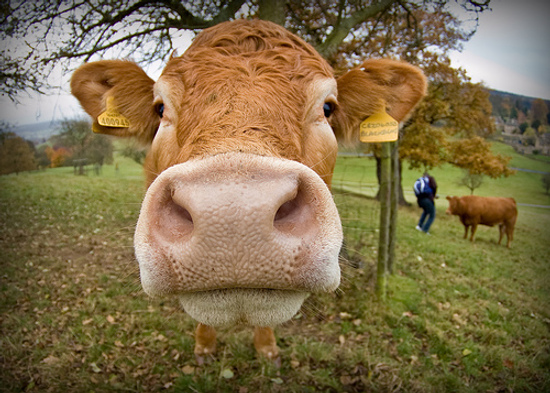
In short - a day of amazing food and good company!
To learn more about the event, go to Soul Food Farm’s face book page or follow the link :
We greatly appreciate any efforts on your behalf in spreading the word and fundraising for these three worthy organizations!
Spotted on Sunday (SOS)
Glad to report my 8 year-old-son Billy had his first surfing experience today, courtesy of my awesome co-worker Manav Thapar. Billy had no fear, and much tenacity, as he learned and was successful standing up several times on the board! I was too busy cheering him on to catch him on the waves, but here are a few shots of his wetsuit experience:
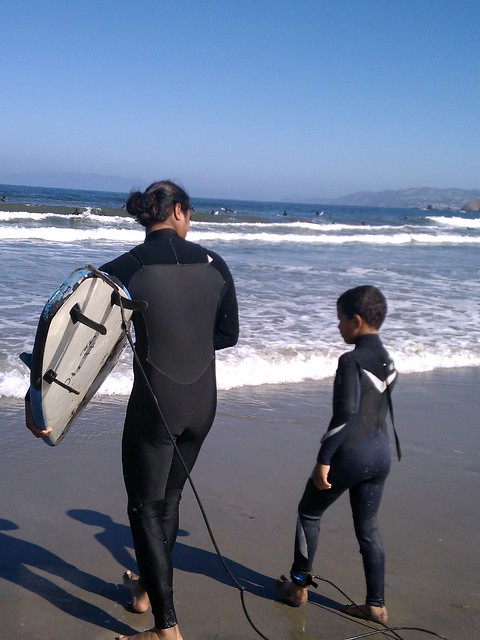

And Teresa Baker followed up with a shot of natural beauty in Big Sur, California!
Where were you Spotted on Sunday?
September's Bird of the Month: Warbling Vireo
By Douglas "Birdman" Gray
I've seen some great birds lately. Some distinctive ones. Some rare ones. Some colorful ones. Some with very lovely songs. But the bird that impressed me most over the last month is, for the most part, none of those things.
This month's featured bird is the impressive (for me anyway) Warbling Vireo.

Walking through almost any wooded area in Indiana (or any wooded area in the United States for that matter) you will likely hear the Warbling Vireo singing its pleasant song. (The mnemonic of "If I see you, I will seize you, and I'll squeeze you till you squirt!" is very useful in identifying and remembering this bird’s song.)
While easily heard, the Warbling Vireo can be difficult to spot. They tend to perch themselves high in treetops. When they are seen, this common bird is often described as "nondescript". I’ve heard it said, amongst birders, "If it's in a tree and it has a totally nondescript plumage, then it must be a Warbling Vireo."
This vireo is indeed a rather drab bird. It has a grayish/olive-gray back, a somewhat whitish breast that sometimes has a yellowish wash, an almost indiscernible dull white stripe over the eyes, and bluish/grayish legs. No wingbars. No tail spots. No eye ring.
OK.........I know the Warbling Vireo is rather plain and isn't impressive to look at. But while most other birds are hunkered down and shunning the midday sun, in the "dog days of summer", this bird will be singing. It's as if this bird is saying, "I know it's hot, but I'm glad. I know it's hot, but I'm grateful. Things could be better, but I'm gonna sing." That impresses me!
I think humans could learn a thing or two by observing the impressive Warbling Vireo.

Douglas “Birdman” Gray has been birding almost all of his life. He grew up on a family farm near Clarksville, Tennessee, where they grew crops ranging from apricots to wheat, and most things in between. They also raised chickens, guineas, pigs, horses, and a cow named…….Apples. Doug’s grandfather identified the birds they would see daily on the farm.
Doug now resides in Indianapolis and works in Parenteral Engineering with Eli Lilly and Company. Most of his current birding takes place in Indiana, with a concentration on Central Indiana, where he leads bird walks for “Backyard Birds”. Doug can be reached at 317-255-7333.
A Trip to the Sequoias: A Family Discovers a National Park
Contributed by Outdoor Afro Gloria Knox of Los Angeles, CA
This summer my family took the opportunity to reconnect with nature. In planning the obligatory summer vacation, my husband and I realized we were short on time and funds. We decided that a trip to an in-state National Park would maximize our summer vacation experience and be cost effective. We visited both Sequoia and Kings Canyon National Parks in California, and it was one of the best experiences we could have had.
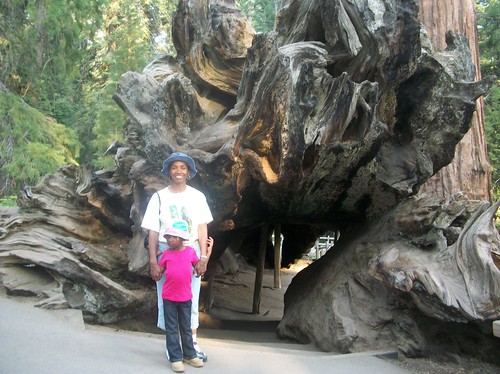
Our initial plan was to rent a recreational vehicle to take to the parks. But there were some maintenance issues with the RV we were going to borrow, so we ended up staying at a hotel just a few miles outside of Sequoia National Park. While it seems like it would be ideal to stay inside a National Park (and we will likely do that next time), I enjoyed staying outside of the park. There was a lot to see and do in the little town outside of the National Park. The hotel seemed to be much less congested than the campgrounds within the park. Also, there was a pool at the hotel that my daughter had to visit each evening after coming off the mountain.
Our first night we had dinner just outside of the park, at a restaurant that was built adjacent to a river. The restaurant was completely open, only floors and ceilings and one could see and hear the water rushing by. It was romantic and the experience of having dinner outside, in the mountains, with the sound of the water washing over the rocks was exhilarating.
The next day we set out for Sequoia National Park. We first visited the Giant Forest Museum. There they provided detailed information about the history of the Park and of the Sequoia trees. There were numerous displays detailing how large the Sequoia Trees were as compared with other common man-made structures such as a football field, etc.
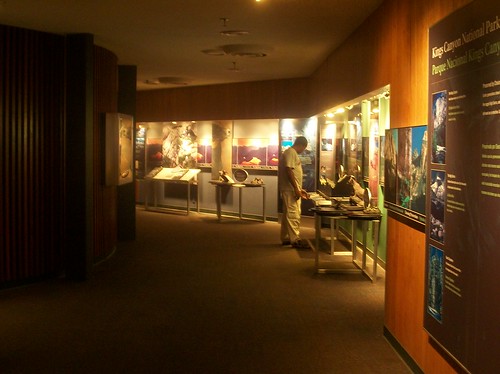
Next we took a self-guided hike on a nature trail. We saw many trees and plants that were native to the area, and a variety of birds. And a passing park ranger pointed out some relatively fresh bear paw prints, but we did not see any bears, although I was interested in seeing a bear…from a safe distance!
Sequoia National Park is divided into several villages. We drove to another area where there is an upscale hotel, the Wuksachi Hotel in Wuksachi Village. It looked very nice, somewhat isolated and very expensive. We drove to Lodgepole Village to have a late lunch. This was a major campground area, with RV’s and tents everywhere. There was an eatery, a wonderful gift shop/general store, laundromat and another visitor’s center - lots of activity. In the middle of it all, we enjoyed a wonderful lunch and followed by the Visitors Center.
Check out the rest of our photos:

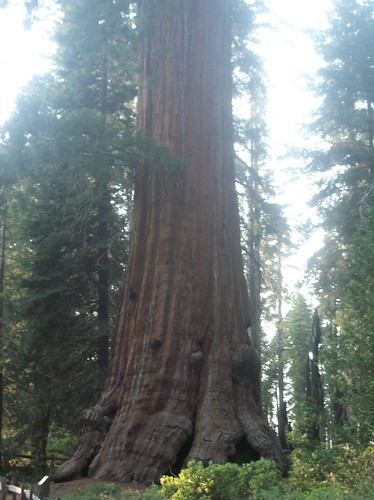
On Thursday, we planned to visit Kings Canyon National Park, but when we arrived at Sequoia, we were told that there had been an accident on the road between the two parks and that the road would be closed for the next 1-2 hours, so we decided to further explore Sequoia. We visited the Beetle Rock Education Center. It was an educational center designed for children to teach them about the great outdoors. My daughter loved it.
We finally were able to get on the road again and made our way to Kings Canyon. First, we visited the Visitors Center in Grant Grove Village to get an overall history of the National Park. We then took a hike to the General Grant Tree—the largest tree in Kings Canyon National Park. After that experience it was time to make our way home. We had a great time and learned a lot about our National Parks. We cannot wait to visit more of the many National Parks!




